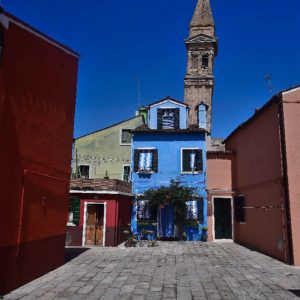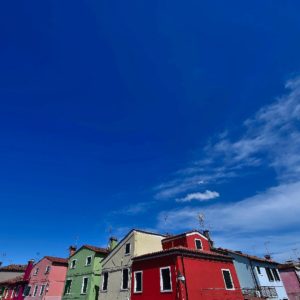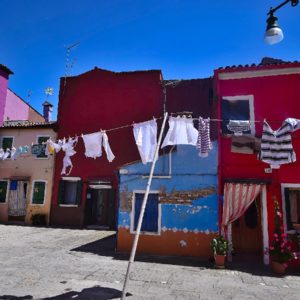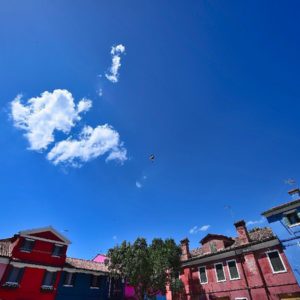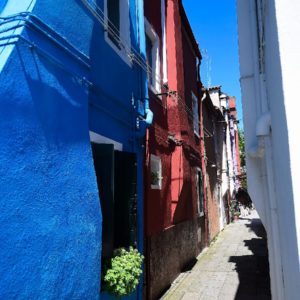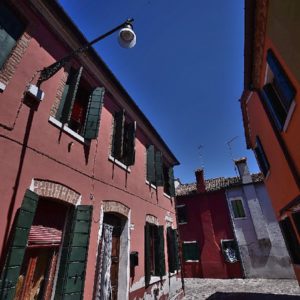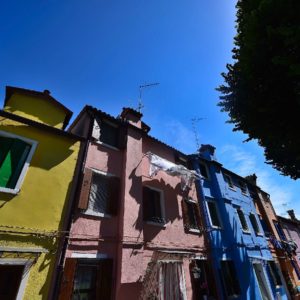Senza Umani … andando a Burano
Burano (Buràn /bu’ran/ in veneto) è un centro abitato di 2.426 abitanti che sorge su quattro isole della laguna di Venezia settentrionale. Fa parte del comune di Venezia e in particolare della municipalità di Venezia-Murano-Burano. È collegato da un ponte all’isola di Mazzorbo, che ne è divenuta una sorta di appendice. La cittadina è nota per le sue tipiche case vivacemente colorate e per la secolare lavorazione artigianale ad ago del merletto di Burano. Notevoli sono le tradizioni gastronomiche; tipici dolci sono i bussolai. Fino al 2005 l’ex quartiere Burano comprendeva, oltre a Burano, anche Torcello, Mazzorbetto, Mazzorbo ed alcune isole minori[1].
La tradizione vorrebbe che Burano fosse stata fondata, come i centri dei dintorni, dagli abitanti della città romana di Altino che si erano rifugiati in laguna per sfuggire alle invasioni barbariche, in particolare agli Unni di Attila e ai Longobardi.
La prima attestazione documentaria, comunque, risale all’840 quando nel Pactum Lotharii viene citata – al genitivo – Burani[4].
Le prime abitazioni erano poste su palafitte con le pareti fatte di canne e fango e solo a partire dall’anno Mille furono costruite case in mattoni. Burano poteva godere anche di un clima mite e salubre grazie ad una certa ventilazione che allontanava la malaria. Il governo locale, di tipo comunale, cadde ben presto sotto l’orbita di Venezia a cui rimase sempre legata.
Nel corso dei secoli, alcune famiglie di Burano si trasferirono ad Ancona per motivi di lavoro, dove costituirono una piccola comunità: quella dei Buraneli. L’influsso della loro presenza si sente ancor oggi nel dialetto anconitano, essendo la parlata di Burano, insieme a quella autoctona e a quella levantina, una delle tre componenti che si fusero per dare origine al dialetto del capoluogo marchigiano[6].
Fu comune autonomo sino al 1923, anno in cui fu aggregata a Venezia con Murano e Pellestrina. Il suo territorio si estendeva anche sull’attuale Cavallino-Treporti e sulle isole di Mazzorbo, Torcello, Santa Cristina, Cason Montiron, La Cura, San Francesco del Deserto.
Burano (Buran / bu’ran / in Veneto) is an inhabited town of 2,426 inhabitants on four islands in the northern Venice lagoon. It is part of the municipality of Venice and in particular of the municipality of Venice-Murano-Burano. It is connected by a bridge to the island of Mazzorbo, which has become a kind of appendix. The town is known for its vibrantly colorful houses and for the centuries-old craftsmanship of Burano’s Lace Needle. Noteworthy are the gastronomic traditions; Typical sweets are the bushes. Until 2005, the former Burano district included, in addition to Burano, Torcello, Mazzorbetto, Mazzorbo and some smaller islands [1].
Tradition would like Burano to be founded, like the neighborhood centers, by the inhabitants of the Roman city of Altino who had taken refuge in the lagoon to escape the barbarian invasions, especially the Huns of Attila and the Longobards.
The first documentary attestation, however, dates back to 840 when Pactum Lotharii was cited – genitive – Burani [4].
The first houses were put on piles with walls made of canes and mud and only from the year one thousand were built brick houses. Burano could also enjoy a mild and healthy climate thanks to a certain ventilation that removed malaria. Local government, of the municipal type, soon fell under the orbit of Venice to which it was always bound.
Over the centuries, some Burano families moved to Ancona for work, where they formed a small community, the Buraneli family. The influence of their presence is still felt in the dialect of Anconitano, as Burano’s speech, together with the native and the Levantine one, is one of the three components that merged to give rise to the dialect of the Marche’s capital [6].
It was autonomous until 1923, when it was aggregated in Venice with Murano and Pellestrina. Its territory also extended to the present Cavallino-Treporti and the islands of Mazzorbo, Torcello, Santa Cristina, Cason Montiron, La Cura, Saint Francis of the Desert.
The images contained in this site are protected by copyright, any type of use is prohibited unless authorized in writing by the author who owns the rights. The total or partial reproduction, even if it shows the watermark or if the author is indicated, will be followed by the issue of an invoice and the subsequent request for payment in accordance with the law, the prohibition is also extended to sharing on social media (Facebook , Instagram, Linkedin etc.).
Le immagini contenute in questo sito sono protette da diritti d’autore, ne è vietato qualsiasi tipo di utilizzo se non autorizzato per iscritto dall’autore proprietario dei diritti. La riproduzione totale o parziale, anche se riporta il watermark o se ne indica l’autore, sarà seguita dall’emissione di una fattura e la successiva richiesta di pagamento a termini di legge, il divieto è esteso anche alla condivisione sui social media (Facebook, Instagram, Linkedin ecc.).
#love #nature #beautiful #art #artist #design #food #FAMILY #work #Enjoy #travel#photo #photooftheday #picoftheday #photography #instagram #instagood #instalike #inspiration #instadaily #composition #photoshoot #love #landscape #luxury #selfie #life #repost#umcartistphotographerchefsculptorstylist #ugomariacionfriniartistphotographerchefsculptorstylist #ugomariacionfriniartistafotografoconilcuore #like4like #follow4follow
All images published on this site are granted for the sole purpose of consultation, all other uses are prohibited under Law 633/41 and subsequent amendments and pursuant to the Berne Convention on Copyright. The name of the author’s name is mandatory, pursuant to Presidential Decree 19/79
Tutte le immagini pubblicate su questo sito sono concesse per la sola consultazione, tutti gli altri utilizzi sono interdetti ai sensi della legge 633/41 e successive modifiche e ai sensi del Trattato Internazionale di Berna sul Diritto d’Autore. La menzione del nome dell’autore è obbligatoria, ai sensi del DPR 19/79
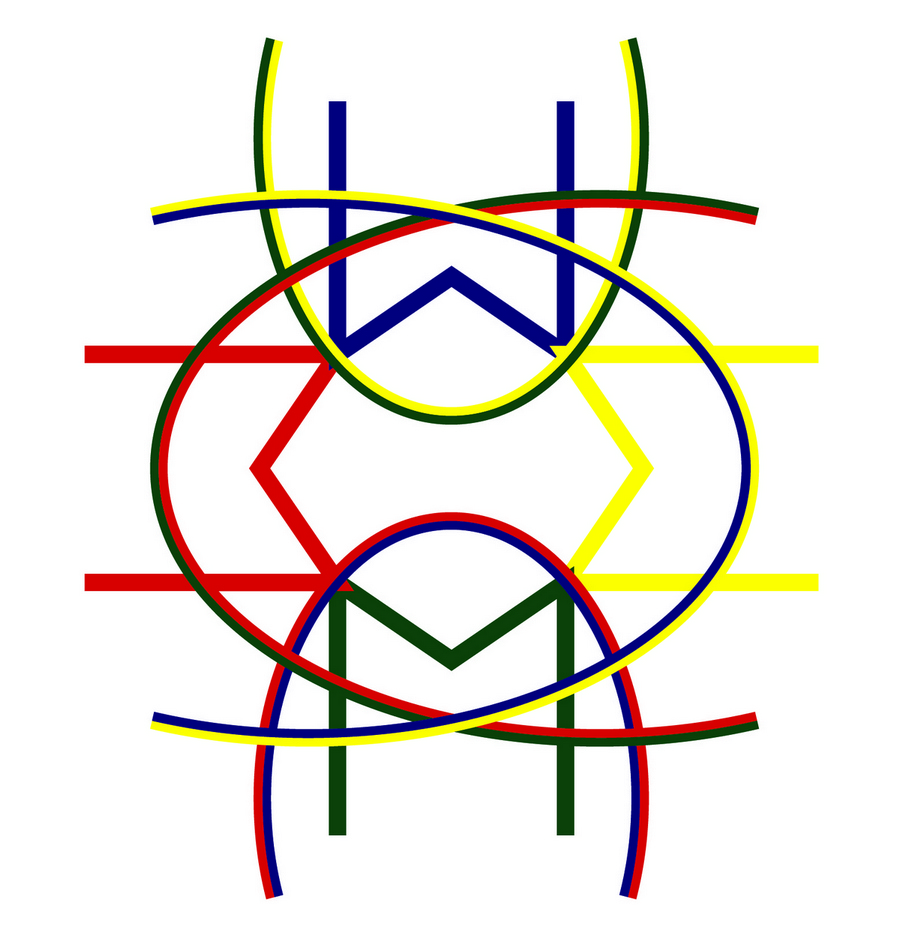

 Italiano
Italiano
